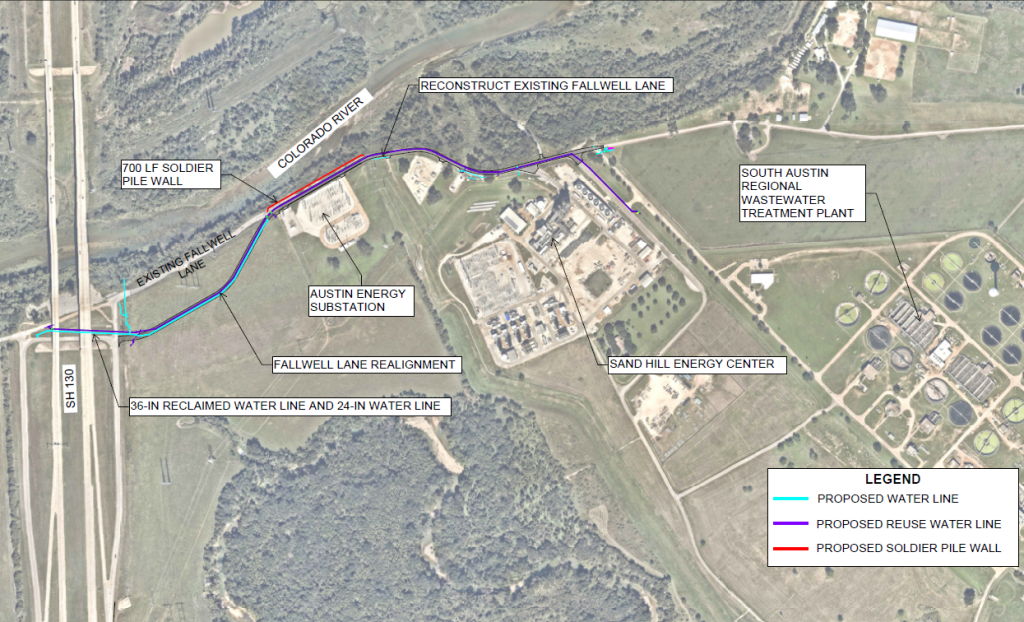Map of Project Area

Project Overview
Fallwell Lane provides critical access to the City of Austin’s South Austin Regional Wastewater Treatment Plant and the Sand Hill Energy Center. During major flood events in 2013 and 2015, flooding from Onion Creek caused significant erosion along the Colorado River bank, damaging Fallwell Lane and threatening nearby utility infrastructure.
The project will reconstruct and realign portions of Fallwell Lane farther from the river to reduce flood risk, stabilize eroding streambanks, and improve drainage infrastructure. These improvements will help protect critical City facilities, reduce the impacts of future flood events, and ensure reliable access to the wastewater treatment plant and energy facilities.
Project Features
- Reconstruction of Fallwell Lane at-grade, with portions of the roadway realigned away from the Colorado River to reduce flood risk;
- Realignment and upgrades to water and reuse water utilities within the project corridor;
- Streambank stabilization using a combination of “soft” restoration techniques and engineered stabilization measures;
- Construction of a soldier pile wall to protect Fallwell Lane and the Onion Creek Substation from erosion;
- Installation and replacement of pipe and box culverts to improve drainage and reduce future erosion.
Background
Fallwell Lane provides primary access to the City’s South Austin Regional Wastewater Treatment Plant (SAR WPT) and the Sand Hill Energy Center and are critical in the operation of City utilities. On October 31, 2013, and October 30, 2015, Onion Creek flood waters inundated low areas as they flowed into the Colorado River where bank erosion was severe, requiring extensive restoration and stabilization. The flood water severely damaged Fallwell Lane, threatened the raw water intake structure at the Sand Hill Energy Center, and damaged SAR WTP.

2015 Flood Event over Fallwell Lane
It has been estimated that a single catastrophic flood event at the facilities could cause losses of over $1.6 billion at the site. An extended outage could severely hamper Austin’s recovery after a flood and risk neutralizing the many resilience measures that Austin has implemented through a variety of community plans. Under flood conditions, both plants would be inoperable and unable to generate electricity or treat wastewater. SAR represents half the wastewater treatment plant capacity of the City of Austin, and SHEC represents 23% of the base load power capacity.
The City of Austin has previously contracted with a wide variety of professional service firms including engineering, environmental, geotechnical, and mapping providers to investigate solutions for the project area. The City evaluated holistic alternative infrastructure improvements for Fallwell Lane and adjacent facilities. The result of that study was a Preliminary Engineering Report (PER) that forms the basis of much of this narrative and resulted in $8.8 million of CDBG-MIT grant funding.
Temporary measures have been put in place to allow local traffic to utilize Fallwell Lane, however, these temporary measures have a limited useful life and have shown signs of deterioration. The southern bank of the Colorado River is eroding, and Fallwell Lane is showing signs of stress. A permanent solution to reconstruct or realign key access roads, retrofit water intake structures, and stabilize berms and channels to guard against flood overflows from Onion Creek are needed to protect critical City infrastructure from future flood events.

Fallwell Lane Failure
Estimated Budget
$31.8 million
The project is fully funded through the capital budgets of Austin Water, Austin Energy, Austin Transportation and Public Works, and Austin Watershed Protection. Additional funding is provided through three FEMA grants administered by the Texas Department of Emergency Management and an $8.8 million U.S. Department of Housing and Urban Development (HUD) Community Development Block Grant–Mitigation (CDBG-MIT) grant administered by the Texas General Land Office.
Anticipated Project Schedule
- Estimated duration: approximately 550 days to substantial completion from the Notice to Proceed issued on October 13, 2025.
Project Status
Construction is underway. Current and upcoming work activities include:
Completed work
- Clearing and grubbing;
- Erosion control measures;
- Site preparation.
Ongoing/next three months
- Utility and drainage work;
- Construction of the newly aligned portion of Fallwell Lane;
- Drilling shafts for the soldier pile wall.
Next six months
- Traffic shifted to new roadway by end of June;
- Removal of old Fallwell Lane.
Construction Impacts
- Occasional lane closures and/or utility shutoffs may occur during construction;
- Flaggers may be present to direct traffic;
- Ongoing construction activity in the area.
Project Links
Contacts
- Send an email to Craig McColloch, Project Manager
- Send an email to Luis Cordova, Austin Energy Sponsor
- Send an email to Jake Spelman, Austin Energy Sponsor
- Send an email to Heraclio Bernal, Austin Water Sponsor
- Send an email to Brent Crawford, Austin Water Sponsor
- Send an email to Peter Morales, Engineering Construction Coordinator Supervisor
- Send an email to Michael Reyes, Engineering Construction Coordinator

